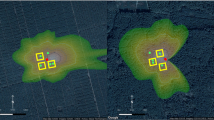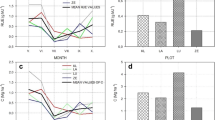Summary
In May 1992 during the interdisciplinary measurement campaign HartX (Hartheim eXperiment), several independent estimates of stand water vapor flux were compared at a 12-m high Scots pine (Pinus silvestris) plantation on a flat fluvial terrace of the Rhine close to Freiburg, Germany. Weather during the HartX period was characterized by ten consecutive clear days with exceptionally high input of available energy for this time of year and with a slowly shifting diurnal pattern in atmospheric variables like vapor pressure deficit. Methods utilized to quantify components of stand water flux included porometry measurements on understory graminoid leaves and on pine needles and three different techniques for determining individual tree xylem sap flow. Micrometeorological methods included eddy covariance and eddy covariance energy balance techniques with six independent systems on two towers separated by 40 m. Additionally, Bowen ratio energy balance estimates of water flux were conducted and measurements of the gradients in water vapor, CO2, and trace gases within and above the stand were carried out with an additional, portable 30 m high telescoping mast.
Biologically-based estimates of overstory transpiration were obtained by up-scaling tree sap flow rates to stand level via cumulative sapwood area. Tree transpiration contributed between 2.2 and 2.6 mm/day to ET for a tree leaf area index (LAI) of 2.8. The pine stand had an understory dominated by sedge and grass species with overall average LAI of 1.5. Mechanistic canopy gas exchange models that quantify both water vapor and CO2 exchange were applied to both understory and tree needle ecosystem compartments. Thus, the transpiration by graminoid species was estimated at approximately 20% of total stand ET. The modelled estimates for understory contribution to stand water flux compared well with micrometeorologically-based determinations. Maximum carbon gain was estimated from the canopy models at approximately 425 mmol/(m2day) for the tree needles and at 100 mmol/(m2day) for the understory. Carbon gain was suggested by the modelling analysis to remain relatively constant during the HartX period, while water use efficiency in carbon fixation increased with decreasing vapor pressure deficit. Biologically- and micrometeorologically-based estimates of stand water flux showed good general agreement with variation of up to 20% that reflects both errors due to the inherent assumptions associated with different methods as well as natural spatial variability in fluxes. The various methods support a reliable estimate of average ET from this homogeneous canopy during HartX of about 2.6 mm/day (a maximum of about 3.1 mm/day) with an insignificant decreasing trend in correlation with decreasing vapor pressure deficit and possibly soil moisture.
Findings during HartX were embedded in local scale heterogeneity with greater roughness over the forest and much higher ET over the surrounding agricultural fields which results in weak but clearly existant circulation patterns. A variety of measurements were continued after the HartX campaign. They allow us to extend our findings for six months with changing environmental conditions, including shortage of soil moisture. Hydrological estimates of soil water extractions and micrometeorological estimates of ET by the one-propeller eddy covariance (OPEC) system were in very good agreement, supporting the use of this robust eddy covariance energy balance technique for long-term monitoring.
Similar content being viewed by others
References
Baldocchi, D. D., 1994: A comparative study of mass and energy exchange over a closed C3 (wheat) and an open C4 (corn) canopy: I. The partitioning of available energy into latent and sensible heat exchange.Agric. Forest Meteor. 67, 191–220.
Bernhofer, Ch., Blanford, J. H., Siegwolf, R., Wedler, M., 1996: Applying single and two-layer canopy models to derive conductances of a Scots pine plantation from micrometeorological measurements.Theor. Appl. Climatol. 53, 95–104.
Blanford, J. H., Gay, L. W., 1992: Tests of a robust eddy correlation system for sensible heat flux.Theor. Appl. Climatol. 46, 53–60.
Ernst, S., Wüthrich, M., 1996: Spatial characteristics of surface and atmospheric properties during HartX.Theor. Appl. Climatol.,53, 59–67.
Gay, L. W., Vogt, R., Bernhofer, Ch., Blanford, J. H., 1996a: Flux agreement above a Scots pine plantation.Theor. Appl. Climatol. 53, 33–48.
Gay, L. W., Vogt, R., Kessler, A., 1996b: The May–October energy budget of a Scots pine plantation at Hartheim, Germany.Theor. Appl. Climatol. 53, 79–94.
Granier, A., Biron, P., Köstner, B., Gay, L. W., Najjar, G., 1996: Comparison of sap flow and water vapour flux at the stand level and derivation of canopy conductance for Scots pine.Theor. Appl. Climatol. 53, 115–122.
Jaeger, L., Kessler, A., 1996: The HartX period May 1992, seen against the background of twenty years of energy balance climatology at the Hartheim pine forest.Theor. Appl. Climatol. 53, 9–21.
Jarvis, P. G., 1976: The interpretation of the variations in leaf water potential and stomatal conductance found in canopies in the field.Phil. Trans. Roy. Soc. London 273, 593–610.
Joss, U., Graber, W. K., 1996: Profiles and simulated exchange of H2O, O3, NO2 between the atmosphere and the HartX Scots Pine Plantation.Theor. Appl. Climatol. 53, 157–172.
Joss, U., 1995: Mikrometeorologie, Profile und Flüsse von CO2, H2O, NO2, O3 in zwei mitteleuropäischen Nadelwäldern. Inaugoraldissertation, Univ. Basel, Switzerland, pp. 134.
Kessler, A., Jaeger, L., 1994: Mittlere Tages- und Jahresgänge der Strahlungsbilanz und ihrer Komponenten über einem südwestdeutschen Kiefernwald. Eine klimatische Interpretation.Erdkunde, Arch. f. wiss. Geogr. 48, 14–33.
Kessler, A., Jaeger, L., Schott, R., 1979: Die Auswirkungen der Sonnenfinsternis vom 29. April 1976 auf die Energieströme eines Kiefernwaldes.Meteorol. Rdsch. 32, 109–115.
Kessler, A., Müller, R., Jaeger, L., 1988: Der Wasserhaushalt eines Kiefernwaldes und Wechselwirkungen mit dem Energiehaushalt. Eine klimatökologische Studie.Erdkunde, Arch. f. wiss. Geogr. 42, 177–187.
Köstner, B., Biron, P., Siegwolf, R., Granier, A., 1996: Estimates of water vapor flux and canopy conductance of Scots pine at tree level utilizing different xylem sap flow methods.Theor. Appl. Climatol. 53, 105–113.
McNaughton, K. G., Jarvis, P. G., 1983: Predicting effects of vegetation changes on transpiration and evaporation. In: Koslowski, T. T. (ed.)Water Deficits and Plant Growth, Vol. VII. New York, London: Academic Press, pp. 1–47.
Parlow, E., 1996: The regional climate project REKLIP — an overview.Theor. Appl. Climatol. 53, 3–7.
Schott, R., 1980: Untersuchungen über die Energiehaushaltskomponenten in der atmosphärischen Grenzschicht am Beispiel eines Kiefernbestandes in der Oberrheinebene (Hartheim/Rh.).Ber. Deutscher Wetterd., 153, 58 pp.
Stewart, J. B., 1988: Modelling surface conductance of pine forest.Agric. Forest. Meteorol. 43, 17–35.
Sturm, N., Reber, S., Kessler, A., Tenhunen, J. D., 1996: Soil moisture variation and plant water stress at the Hartheim Scots pine plantation.Theor. Appl. Climatol. 53, 123–133.
Tenhunen, J. D., Siegwolf, R. A., Oberbauer, S. F. 1994: Effects of phenology, physiology and gradients in community composition, structure, and microclimate on tundra ecosystem CO2 exchange. In: Schulze, E.-D., Caldwell, M. M. (eds.)Ecophysiology of Photosynthesis. Berlin Heidelberg, New York: Springer, pp. 433–460 (Ecol. Studies, Vol. 100).
Tenhunen, J. D., Joss, U., Siegwolf, R., Bürgler, M., Falge, E., Geyer, R., 1995: Estimation of CO2 fixation and water loss byPinus silvestris at the Hartheim plantation with a canopy gas exchange model. (In preparation).
Vogt, R., Bernhofer, Ch., Gay, L. W., Jaeger, L., Parlow, E., 1996: The available energy above a Scots pine plantation: What's up for partitioning?Theor. Appl. Climatol. 53, 23–31.
Vogt, R., 1995: Theorie, Technik und Analyse der experimentellen Fluβbestimmung am Beispiel des Hartheimer Kiefernwaldes. Ein Beitrag zu den Energiebilanzuntersuchungen im REKLIP. Geographisches Institut Basel,stratus 3, 101 pp.
Wedler, M., Geyer, R., Heindl, B., Hahn, S., Tenhunen, J. D., 1996a: Leaf-level gas exchange and scaling-up of forest understory carbon fixation rates with a “patch-scale” canopy model.Theor. Appl. Climatol. 53, 145–156.
Wedler, M., Heindl, B., Hahn, S., Köstner, B., Bernhofer, Ch., Tenhunen, J. D., 1996b: Model-based estimates of water loss from “patches” of the understory mosaic of the Hartheim Scots pine plantation.Theor. Appl. Climatol. 53, 135–144.
Wicke, W., 1988: Studium zu einem Verdunstungsmodell für einen Wald. Diplomarbeit, Lehrstuhl fur Geographie und Hydrologie, Universität Freiburg.
Wicke, W., Bernhofer, Ch., 1996: Energy balance comparison of the Hartheim forest and an adjacent grassland site during the HartX experiment.Theor. Appl. Climatol. 53, 49–58.
Wüthrich, M., 1996: Thermal infra-red underflights compared to ERS-1 C-band synthetic aperture radar focusing soil moisture distribution.Theor. Appl. Climatol. 53, 69–78.
Author information
Authors and Affiliations
Additional information
With 5 Figures
Rights and permissions
About this article
Cite this article
Bernhofer, C., Gay, L.W., Granier, A. et al. The HartX-synthesis: An experimental approach to water and carbon exchange of a Scots pine plantation. Theor Appl Climatol 53, 173–183 (1996). https://doi.org/10.1007/BF00866421
Received:
Issue Date:
DOI: https://doi.org/10.1007/BF00866421




